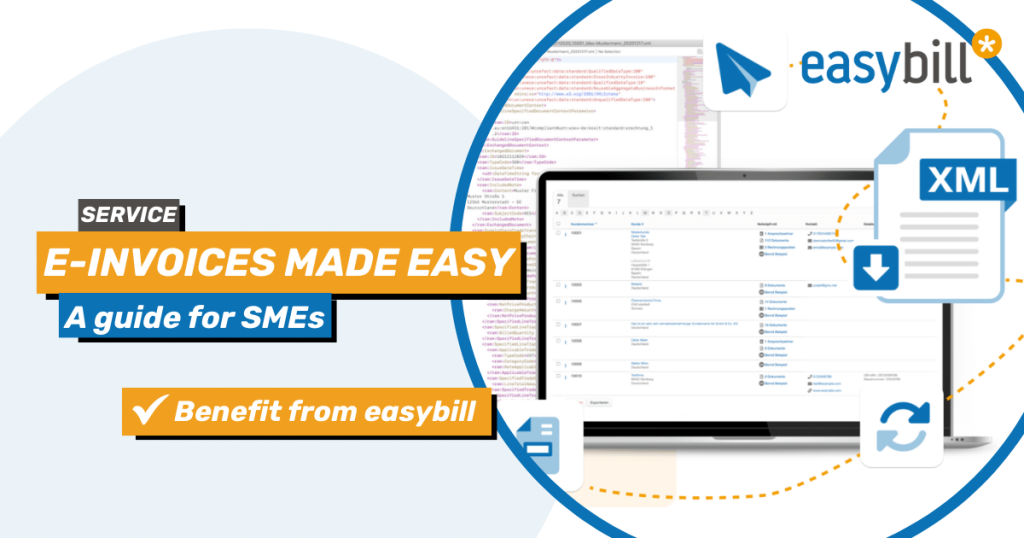
In today’s digital era, where efficiency and speed are key, companies are constantly looking for new ways to optimize their business processes. One such innovation that is helping businesses do this is the introduction of e-invoicing, particularly for small and medium-sized enterprises (SMEs). In this guide, we will take an in-depth look at the process of e-invoicing, explore the benefits of e-invoicing for SMEs, understand the legal requirements and explain best practices for a smooth transition to e-invoicing for SMEs.
What are e-invoices and their advantages?
E-invoices are electronic invoices that can be created, transmitted and processed digitally. In contrast to traditional paper invoices, e-invoices offer numerous advantages for companies, especially SMEs.
- Increased efficiency: By automating invoice processes, companies can save time and resources that would normally be required for the manual processing of paper invoices.
- Cost savings: Using e-invoices reduces paper, printing, postage and storage costs, which can lead to significant cost savings.
- Faster payments: E-invoices enable faster processing and delivery, resulting in shortened payment cycles and improving the company’s liquidity.
- Environmental friendliness: By reducing paper consumption and CO2 emissions, companies make a contribution to environmental protection.
Understanding legal requirements
Bei der Einführung von E-Rechnungen ist es wichtig, die geltenden gesetzlichen Anforderungen zu berücksichtigen, um Konformität sicherzustellen und potenzielle rechtliche Risiken zu minimieren. Diese Anforderungen können je nach Land und Rechtssystem variieren, daher ist es entscheidend, sich mit den spezifischen Vorschriften vertraut zu machen. Typischerweise umfassen gesetzliche Anforderungen Aspekte wie die Authentizität der Herkunft, die Integrität des Inhalts und die Lesbarkeit der Rechnung.
Step-by-step process for conversion
Switching to e-invoicing requires careful planning and implementation. Here is a step-by-step process that can help SMEs make the switch:
- Analysis of current processes: Review your existing invoicing processes and identify areas that can be improved by introducing e-invoicing.
- Selecting a suitable solution: Research various e-invoicing solutions and select one that meets your company’s needs and complies with the applicable legal requirements.
- Implementation and training: Implement the selected e-invoicing solution and train your employees to ensure they can use the new processes effectively.
- Test phase: Carry out a test phase to ensure that the e-invoicing solution works smoothly and that all requirements are met.
- Rollout and monitoring: Roll out the e-invoicing solution gradually and continuously monitor its performance to ensure it is delivering the desired benefits.
Best practices for SMEs
In conclusion, here are some best practices that SMEs should consider when introducing e-invoicing:
- Regular employee training: Make sure your employees have the right skills and knowledge to create and process e-invoices effectively.
- Implement security measures: Implement appropriate security measures to ensure the integrity and confidentiality of your e-invoices and prevent cyber-attacks.
- Continuous improvement: Monitor and evaluate your e-invoicing processes regularly and look for opportunities for continuous improvement and optimization.
Overall, e-invoicing offers a wide range of benefits for SMEs, including increased efficiency, cost savings and improved liquidity. By understanding the legal requirements, carrying out a structured transition process and implementing best practice, SMEs can ensure a smooth transition to e-invoicing and benefit in the long term.
Read also:
How to create a professional invoice in 10 minutes with easybill
Plain language in e-commerce: the power of evaluation management in online stores
easybill feature: document versioning for legally compliant action


